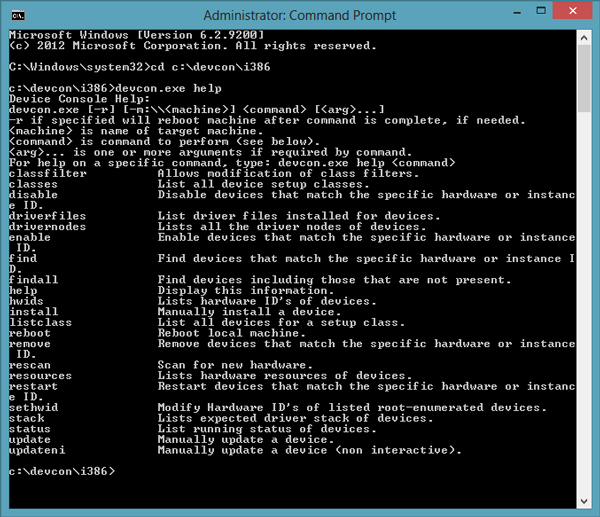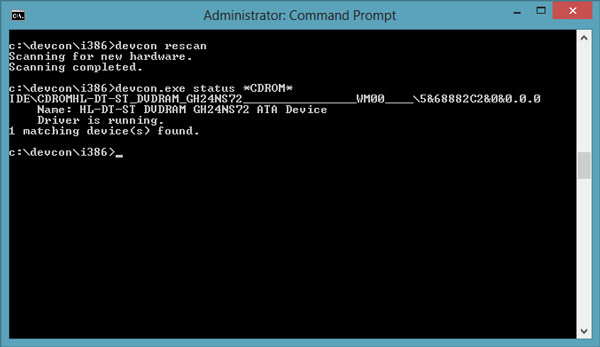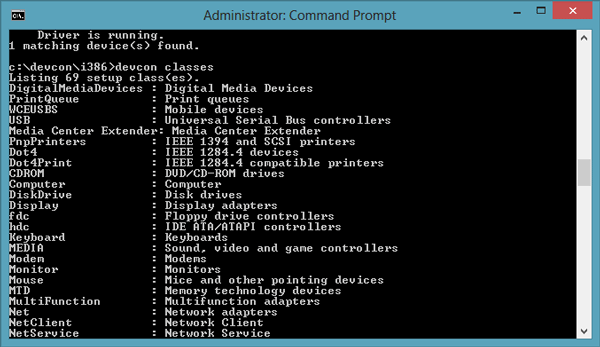To totally unlock this section you need to Log-in
Login
Windows Device Manager is certainly a useful built-in tool to manage, uninstall and disable drivers without having an expert knowledge. The Device Manager seems handy and anyone with some basic knowledge of Windows, can open it and use it. However, today we are going to introduce you to such a program that helps users manage installed Windows drivers, right from the Command Prompt. DevCon is that free command-line utility, which lets users manage drivers from the command line.
devcon for Windows
DevCon is available for Microsoft Windows 2000 or later version and Windows Server 2003. That means that the tool is compatible with all the latest Windows versions such as Windows 8, Windows 8.1, etc.
To begin using this tool, you will have to first, download DevCon from the Microsoft Support website. You will get it for 32-bit version as well as 64-bit version of Windows. After downloading and unzipping the file, you need to choose the version 32-bit or 64-bit, for your Windows computer. Or else, you can also put the entire unzipped DevCon folder inside your System Drive.
Next, open a Command Prompt window with administrative privileges. If you are using Windows 7 or earlier version of Windows, you can do that by searching for cmd in the Start Menu. If you are using Windows 8 or later versions, press Win + X together and select Command Prompt (Admin).
After opening the Command Prompt windows, enter the following command:
cd C:\devcon\i386 (For 32-bit) cd C:\devcon\ia64 (For 64-bit)
C:\devcon is the path where you have placed the unzipped folder.
By entering this command, you have successfully started using DevCon.
Useful commands to manage Windows Drivers using DevCon
DevCon does everything that is possible to do, using Device Manager. But, it just works in a different way – using commands. Although, you can get almost all the supported commands by entering the following command, yet, here are some of them for basic management purpose.
devcon.exe help
If you want to know the status of any hardware, you need to following command:
devcon.exe status [device name]
For instance:
devcon.exe status *CDROM*
Like the Device Manager, you can enable/disable any hardware driver using this tool. For that, you will have to enter this command:
devcon.exe enable [device name] devcon.exe disable [device name]
If you want to know the status, enable or disable any hardware driver, you must know the name of that hardware. In case you do not know, you can get a brief list of all names by entering the following command:
devcon classes
Just like Device Manager, DevCon users can also search for any hardware changes using the following command:
devcon rescan
For those, who want to know more about any particular hardware or device, this command may help:
devcon.exe –m:\\YourComputerName find devicename
You have to enter your computer name to specify your PC as it also works on network computer.
Advantage of using DevCon over Device Manager
The first advantage is that DevCon utility is faster than Device Manager. The second advantage is it has more flexibility. You have more options to control your installed drivers. The third and most exciting advantage of DevCon is you can manage any driver of any Windows PC in your network from any one PC.
Device Console Help
devcon [-r] [-m:\\] [ ...] -r if specified will reboot machine after command is complete, if needed. is name of target machine. is command to perform (see below). ... is one or more arguments if required by command. For help on a specific command, type: devcon help classfilter Allows modification of class filters. classes List all device setup classes. disable Disable devices that match the specific hardware or instance ID. driverfiles List driver files installed for devices. drivernodes Lists all the driver nodes of devices. enable Enable devices that match the specific hardware or instance ID. find Find devices that match the specific hardware or instance ID. findall Find devices including those that are not present. help Display this information. hwids Lists hardware ID's of devices. install Manually install a device. listclass List all devices for a setup class. reboot Reboot local machine. remove Remove devices that match the specific hardware or instance ID. rescan Scan for new hardware. resources Lists hardware resources of devices. restart Restart devices that match the specific hardware or instance ID. stack Lists expected driver stack of devices. status List running status of devices. update Manually update a device.
Use devcon help command for detailed help on command:
C:\>devcon help DriverFiles devcon driverfiles[ ...] devcon driverfiles = [ ...]
Lists driver files installed for devices that match the specific hardware or instance ID. This command will only work for local machine.
Examples of <id> are: * - All devices ISAPNP\PNP0501 - Hardware ID *PNP* - Hardware ID with wildcards (* matches anything) @ISAPNP\*\* - Instance ID with wildcards (@ prefixes instance ID) <class> is a setup class name as obtained from the classes command.
Download
Here you will can download both versions (32-bit and 64-bit) of devcon command line utility (only for registered users).
[wpfilebase tag="file" id="235"]





